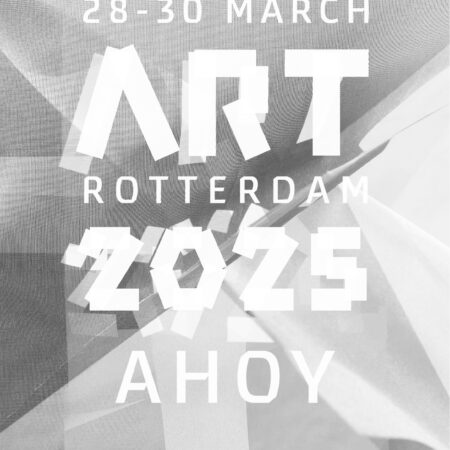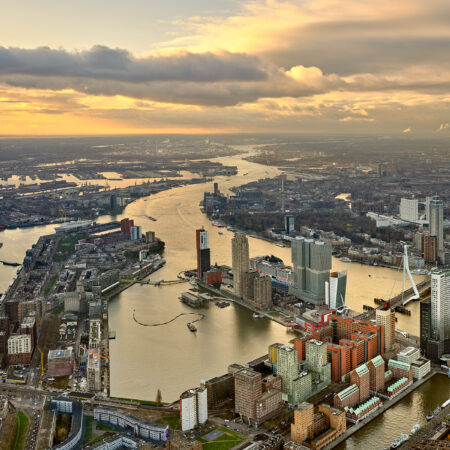The Miami Series Hans Wilschut | Edo Dijksterhuis
New York and San Francisco might compete over the title of ‘most filmed city in the world’, for lovers of television series, Miami is the most recognisable city in the United States. In CSI Miami, Horatio Caine and his forensic team whizz over 8-lane highways from bloody crime scene to dreary suburb. Mass-murderer Dexter clarifies his methods to dispose of bodies against a background of pastel-coloured art-deco houses. And –more retro, but deeply embedded in the collective consciousness- in Miami Vice, Crockett and Tubs zoom by in their Ferrari, passing flashy office towers, or they take a speedboat, trailing off starch white beaches.
On TV, the city is scenery. The city is the background of urban action. This is the playground of bikini babes holding cocktails, the arena for businessmen with mobile phones glued to their ear, the sunlit hell for the homeless who drag their complete life along in a trolley.
In his latest work, artist Wilschut has portrayed Miami. But the city dwellers are remarkably absent in his photographs. Not a human being in sight. Wilschut shows the city without the life, purely and simply as scenery. And as a beholder, you start to ponder about who those people really are. What sort of people would build such megalomaniac towers? How do city folk manoeuvre within that network of asphalt strips? Do they work pleasantly and live nicely surrounded by all that concrete and reflecting glass?
At first glance, Wilschut’s Miami is a giant set of building blocks somebody keeled over. Remarkably sculptural, as a collection of geometric forms, but also fairly sterile and deadly. There is no organic connection between this super hotel and that mega office. Between those places where people eat, sleep, argue, make money and love, puddles of no man’s land, ‘terrain vague’ which you prefer to cross as quickly as possible in your air-conditioned car. And yet, Miami has the image of sexy nightlife city and subtropical retirement place in the minds of thousands of viewers, holiday makers and pensionado’s.
Miami is a city with many faces, faces which are often opposed. Based on the number of inhabitants living below the poverty line, the US Census Bureau branded the ‘The Magic City’ in 2004 as the second poorest city in America. Five years later, the Swiss bank UBS, proclaimed Miami as ‘wealthiest city in the US’, measured in terms of spending power. The heavy industry causes environmental inconvenience, but the city can also flaunt the title ‘cleanest American city 2008’, thanks to Forbes magazine.
Precisely by this, at first glance, distant way of working, Wilschut gives the people behind the statistics and rankings a face in his photographs. He accomplishes this by turning the buildings, the infrastructure and the skyline which form the scenery for daily life, into the leading characters. During the day, the photographer drives around in the city, looking for suitable locations. He jots down addresses in his notebook and takes snapshots. He rides the elevator to the highest floor of bank buildings and checks how their security works. The actual work starts once the sun has set. He then forces his way into the locus delicti of his choice, armed with tripod and camera. At the edge of the night, when the architecture overflows with artificial light, he shoots individual buildings or traffic squares. The result is unreal and almost abstract, like looking at a scale model. The city is reduced to surfaces and lines, especially in the photographs where Wilschut focuses on a façade and where no roof, pavement or horizon can be seen which offers the beholder any support. The large format on which the photographs are printed makes sure that you are sucked into the image as beholder.
The work of Hans Wilschut sometimes reminds of that of the German photographer Michael Wolf. But in Wolf’s photographs of apartment buildings, quite often people can be recognised. They work, give the photographer the finger or simply go about their business. It can be read as an obscure picture filled with human life. Wilschut leaves that element out. He shows the theatre of life, during the lunch break of the actor. What Wilschut does is more than mere architecture photography. He is not only interested in the forms and rhythm of the image. He reveals the stories and the underlying emotions. The nostalgia of a lamp post next to a parking guard’s booth, the irony of a residential complex with the name ‘Court’, elevated on concrete pillars above an asphalt strip which does not even come close to a square, the mechanic sensuality of a highway piercing through a shopping mall.
Long after Crocket, Tubs, Horatio and Dexter have gone, this scenery which bears the traces of their actions, is still there. That is what Wilschut captures. He is actually engaged in a form of ad hoc archaeology. With his camera, he blows the dust from a civilisation and shows it to us without the buzz of daily life. He captures history as it is happening.


